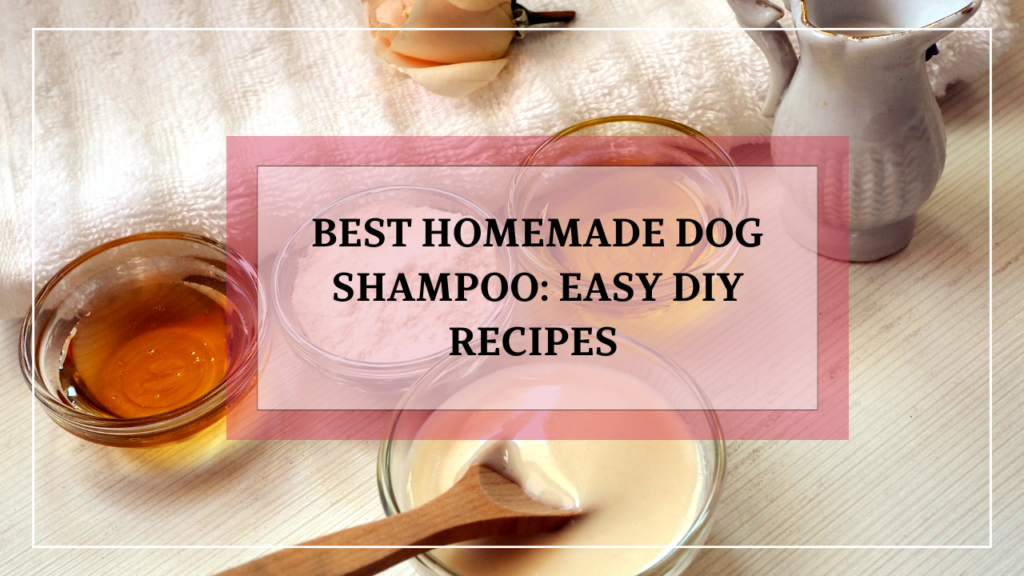Finding the best homemade dog shampoo can be a game-changer for your furry friend. Many commercial dog shampoos contain chemicals that may irritate your dog’s skin or trigger allergies. By creating your own shampoo at home, you not only avoid harmful ingredients but also customize the shampoo to meet your dog’s specific needs. In this guide, we will explore the benefits of homemade dog shampoo, share easy recipes, and provide tips for keeping your dog’s coat healthy and shiny.
Why Choose Homemade Dog Shampoo?
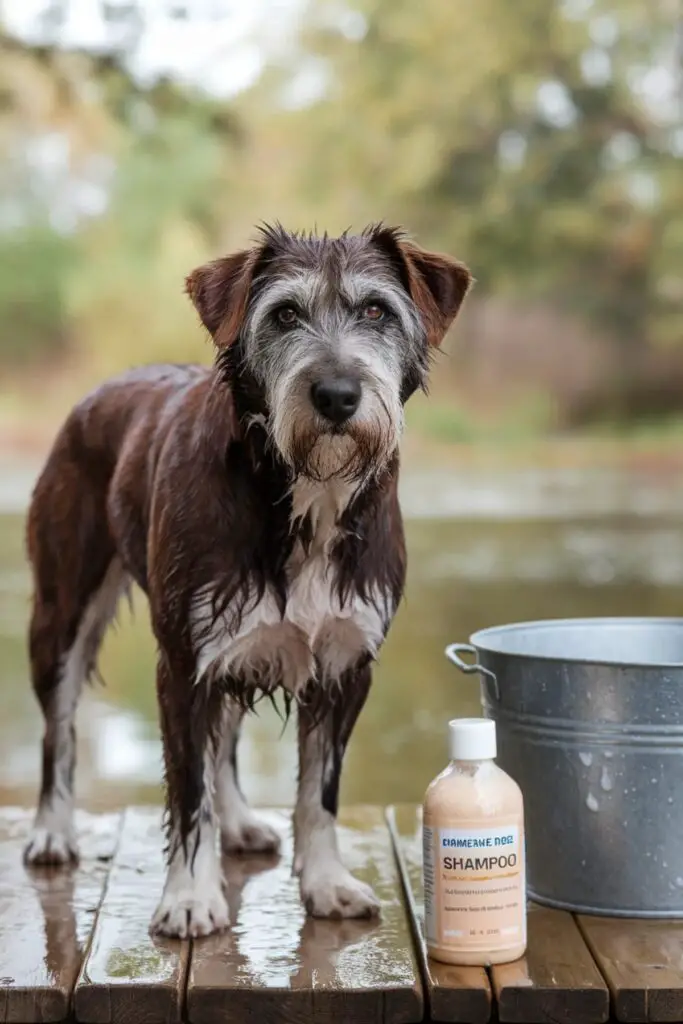
Benefits of Homemade Dog Shampoo
Opting for homemade dog shampoo offers numerous advantages that enhance your pet’s well-being:
- Safety from Harmful Chemicals: Commercial dog shampoos often contain sulfates, parabens, and synthetic fragrances, which can irritate your dog’s skin and lead to allergic reactions. With homemade recipes, you have full control over the ingredients, ensuring they are safe and non-toxic.
- Customization: Every dog is unique, with different skin types and coat conditions. Homemade dog shampoos can be tailored to address specific needs—whether your dog has dry skin, allergies, or an oily coat. You can choose ingredients that are beneficial for your pet’s specific issues.
- Cost-Effectiveness: Making your own dog shampoo can save you money in the long run. Many ingredients used in homemade recipes are commonly found in your kitchen or are inexpensive to purchase.
- Eco-Friendly: By creating your own shampoo, you minimize plastic waste from commercial products. Moreover, you can choose organic and sustainable ingredients, contributing to a healthier planet.
- Bonding Experience: Bath time can become a special bonding moment between you and your dog. Involving your pet in this process can create a positive experience, reducing their anxiety during baths.
Common Ingredients in Store-Bought Shampoos to Avoid
When evaluating commercial dog shampoos, it’s crucial to be aware of harmful ingredients. Here are some common ingredients to avoid:
- Sulfates: These detergents are known to strip the skin of its natural oils, leading to dryness and irritation.
- Parabens: Often used as preservatives, parabens can disrupt hormone function and are linked to skin issues in dogs.
- Artificial Fragrances and Dyes: These synthetic additives can trigger allergies and are unnecessary, as natural ingredients can provide pleasant scents and colors.
By opting for homemade dog shampoos, you ensure a healthier alternative for your furry friend, steering clear of these harmful substances.
Essential Ingredients for the Best Homemade Dog Shampoo
Choosing the right ingredients is crucial for creating the best homemade dog shampoo that effectively cleans your dog’s coat while being gentle on their skin. Here are some safe and effective ingredients to consider, along with their benefits:
Safe and Effective Ingredients to Use
- Oatmeal
- Benefits: Oatmeal is well-known for its soothing properties, making it ideal for dogs with dry or itchy skin. It contains anti-inflammatory compounds that can help alleviate irritation and redness.
- How to Use: Ground oatmeal can be mixed with water to create a paste or added to liquid shampoo recipes.
- Aloe Vera
- Benefits: Aloe vera is a natural moisturizer that promotes healing and helps hydrate dry skin. It contains vitamins, enzymes, and antioxidants that nourish the coat.
- How to Use: Use pure aloe vera gel from the plant, ensuring no added ingredients.
- Coconut Oil
- Benefits: Coconut oil is rich in fatty acids, which provide deep conditioning to the coat. It helps prevent dryness and can even repel fleas.
- How to Use: Melt the coconut oil if solid and mix it into your shampoo recipe for added moisture.
- Apple Cider Vinegar
- Benefits: Apple cider vinegar helps to balance your dog’s skin pH and acts as a natural deodorizer. It can also repel fleas and soothe itchy skin.
- How to Use: Dilute apple cider vinegar with water before adding it to your homemade shampoo.
- Essential Oils (Optional)
- Benefits: Certain essential oils, such as lavender and chamomile, have calming properties and can enhance the scent of your shampoo. However, use them sparingly and ensure they are safe for dogs.
- How to Use: Add a few drops to your shampoo but always check for safe essential oils and dilute them properly.
Ingredients to Avoid
While it’s essential to know what to include in your homemade dog shampoo, it’s equally important to be aware of ingredients to avoid:
- Essential Oils that are Toxic to Dogs: Oils like tea tree oil can be harmful in concentrated amounts. Always research essential oils before use.
- Ingredients Your Dog is Allergic To: If your dog has known allergies, avoid any ingredients that could trigger a reaction.
By selecting safe, effective ingredients, you can create a homemade dog shampoo that cleanses, conditions, and protects your dog’s skin and coat without the risk of irritation.
Easy Recipes for the Best Homemade Dog Shampoo
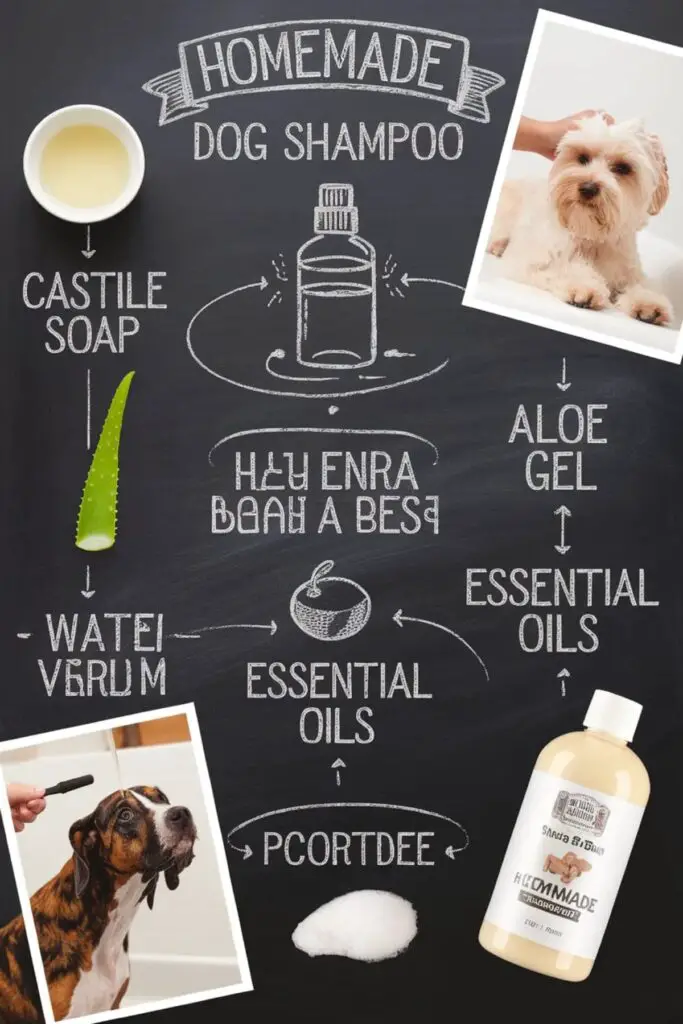
Creating the best homemade dog shampoo can be straightforward and rewarding. Here are some simple recipes you can try, tailored to various needs and preferences. Each recipe focuses on using natural ingredients that are gentle on your dog’s skin and coat while ensuring effective cleansing and conditioning.
1. Oatmeal and Aloe Vera Shampoo

Ingredients:
- 1 cup of ground oatmeal: Oatmeal has long been recognized for its ability to soothe irritated skin. It contains avenanthramides, which are anti-inflammatory compounds that help alleviate itchiness.
- 1/2 cup of pure aloe vera gel: Aloe vera is packed with vitamins A, C, and E, promoting skin healing and hydration.
- 1 cup of warm water: Warm water helps dissolve the ingredients and opens up the hair follicles for better absorption.
Instructions:
- Blend the Oatmeal: In a blender or food processor, grind the oatmeal into a fine powder. This ensures that it will mix smoothly with the other ingredients.
- Mix Ingredients: In a bowl, combine the ground oatmeal, aloe vera gel, and warm water. Stir until well mixed. The mixture should have a creamy consistency, which allows for easy application.
- Application: Wet your dog’s coat thoroughly, apply the shampoo, and massage it into their fur, avoiding the eyes and ears. Rinse thoroughly with warm water. The oatmeal will help to create a soothing lather that is gentle on your dog’s skin.
Benefits: This recipe provides soothing relief for itchy skin and leaves the coat soft and shiny. Oatmeal acts as a natural cleanser while aloe vera hydrates the skin, making it ideal for dogs with allergies or sensitive skin.
2. Coconut Oil and Vinegar Shampoo

Ingredients:
- 1 cup of liquid Castile soap: A plant-based soap that effectively cleanses without harsh chemicals.
- 1/4 cup of coconut oil (melted): Coconut oil not only moisturizes but also has antimicrobial properties that can help protect the skin.
- 1/4 cup of apple cider vinegar: ACV acts as a natural deodorizer and can help restore your dog’s skin’s pH balance, which is essential for maintaining a healthy coat.
- 2 cups of water: Used to dilute the ingredients for easier application.
Instructions:
- Combine Ingredients: In a mixing bowl, whisk together the Castile soap, melted coconut oil, apple cider vinegar, and water until well blended. Ensure that the coconut oil is thoroughly mixed to avoid clumping.
- Transfer to a Bottle: Pour the mixture into a squeeze bottle or a pump bottle for easy application.
- Application: Wet your dog’s coat, apply the shampoo, and lather well. Rinse thoroughly to remove all residue. Pay special attention to areas that tend to retain dirt, such as the underbelly and paws.
Benefits: This shampoo hydrates the coat while balancing skin pH, leaving your dog fresh and clean. The coconut oil adds an extra layer of moisture, making it particularly beneficial for dogs with dry skin. The vinegar helps repel fleas, adding an extra protective layer for your pet.
3. Herbal Infusion Shampoo
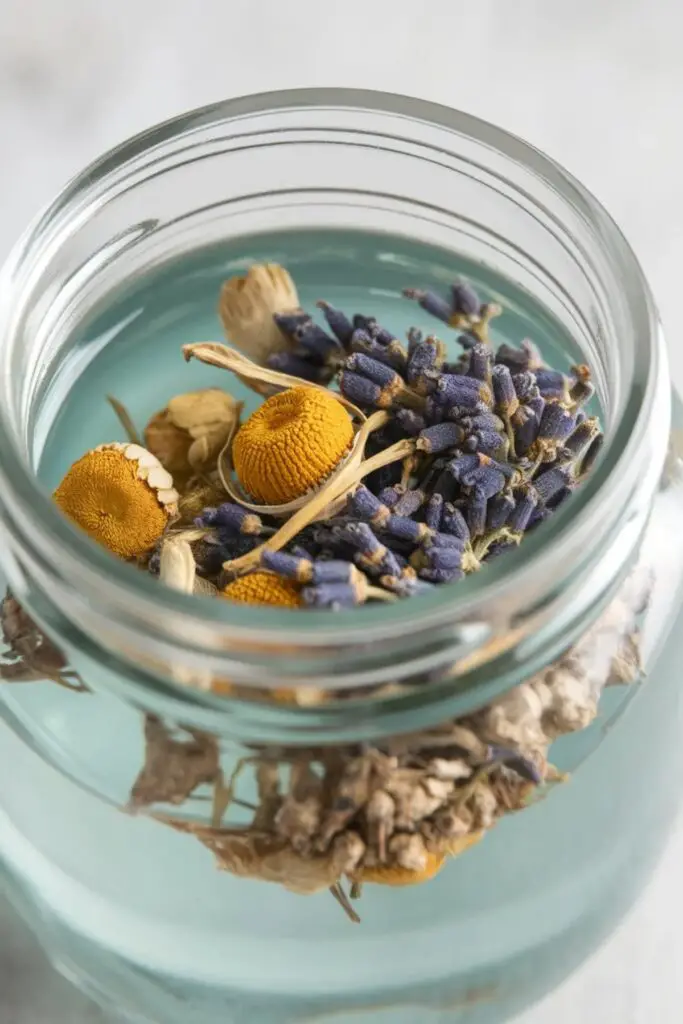
Ingredients:
- 2 cups of water: The base for your herbal infusion.
- 1/2 cup of dried chamomile flowers: Chamomile has calming properties and is also known to soothe irritated skin.
- 1/2 cup of dried lavender flowers: Lavender not only smells great but also has antiseptic and anti-inflammatory properties.
- 1 cup of Castile soap: A gentle cleanser that works well with herbal infusions.
Instructions:
- Prepare the Infusion: In a saucepan, bring the water to a boil, then remove it from heat. Add the dried chamomile and lavender. Let steep for 30 minutes. This infusion process allows the beneficial properties of the herbs to extract fully into the water.
- Strain the Herbs: Strain the infusion through a fine mesh sieve to remove the flowers, ensuring you only keep the liquid. This step is crucial to avoid clogs during application.
- Combine with Soap: Mix the herbal infusion with the Castile soap in a bowl, stirring gently. Avoid creating too many bubbles, which can make application messy.
- Application: Apply to your dog’s wet coat, massage, and rinse thoroughly. The infusion not only cleans but also imparts a calming aroma that can relax your dog during bath time.
Benefits: This recipe not only cleans but also calms and soothes your dog, making it perfect for anxious pups. Chamomile and lavender have been used for centuries for their calming effects, which can help ease anxiety during bath time.
Tips for Storing Your Homemade Shampoo
- Storage: Keep your homemade dog shampoo in a cool, dry place. Using a dark glass container can help protect the ingredients from light, which can degrade the quality of essential oils and other components over time.
- Shelf Life: Most homemade shampoos last about 2-3 weeks, especially if you don’t include preservatives. To extend shelf life, consider making smaller batches that can be used quickly. For a more extended storage option, refrigeration can help maintain freshness but may require warming before use.
- Labeling: Always label your homemade shampoos with the date made and ingredients. This helps keep track of freshness and allows you to avoid using anything that has been stored for too long.
Choosing the Right Ingredients for Homemade Dog Shampoo

When it comes to creating the best homemade dog shampoo, understanding the ingredients you use is vital. Each component plays a specific role in ensuring the shampoo is effective yet gentle on your dog’s skin and coat. Here’s a breakdown of some common ingredients and their benefits:
1. Castile Soap
What It Is:
Castile soap is a plant-based soap that originated from the Castile region in Spain. It is made from olive oil and is free from synthetic additives.
Benefits:
- Gentle Cleansing: Unlike harsh commercial soaps, Castile soap cleanses without stripping natural oils from the skin.
- Biodegradable: Environmentally friendly and safe for water systems.
- Multi-Purpose: Can be used for various household cleaning tasks, making it a versatile ingredient.
2. Coconut Oil
What It Is:
Extracted from the meat of mature coconuts, coconut oil is known for its moisturizing properties.
Benefits:
- Moisturizing: Helps combat dry skin and provides hydration to the coat.
- Antimicrobial Properties: Fights bacteria and fungi, making it beneficial for skin infections and irritations.
- Deodorizing: Neutralizes unpleasant odors, leaving your dog smelling fresh.
3. Oatmeal
What It Is:
Oatmeal, particularly colloidal oatmeal, is finely ground oatmeal known for its skin-soothing properties.
Benefits:
- Soothes Itchy Skin: Reduces inflammation and provides relief from allergies or irritations.
- Natural Emollient: Helps lock in moisture, making it excellent for dry skin.
- Gentle Exfoliation: Removes dirt and debris without harsh scrubbing.
4. Aloe Vera
What It Is:
Aloe vera is a succulent plant known for its healing properties, often used in skincare.
Benefits:
- Hydration: Provides moisture to the skin and coat, reducing dryness.
- Anti-Inflammatory: Helps calm irritated skin and promotes healing.
- Natural Antiseptic: Protects against infections and soothes minor cuts and scrapes.
5. Essential Oils
What They Are:
Essential oils are concentrated plant extracts that carry the scent and properties of the plant.
Benefits:
- Natural Fragrance: Adds a pleasant scent to your homemade shampoo without synthetic fragrances.
- Therapeutic Properties: Certain oils, like lavender and chamomile, can have calming effects, while tea tree oil offers antifungal benefits.
- Flea and Tick Prevention: Some essential oils, such as cedarwood and peppermint, can act as natural repellents.
Note: Always ensure the essential oils you choose are safe for dogs, as some can be toxic. Oils like tea tree, citrus, and eucalyptus should be avoided.
6. Apple Cider Vinegar
What It Is:
Apple cider vinegar is a fermented liquid made from crushed apples, known for its health benefits.
Benefits:
- pH Balancer: Helps maintain your dog’s skin pH, crucial for a healthy coat.
- Natural Deodorizer: Neutralizes odors and freshens up your dog’s fur.
- Flea Repellent: Acts as a deterrent against fleas and ticks when used in small amounts.
7. Herbal Ingredients
What They Are:
Herbs like chamomile, lavender, and rosemary can be infused into your shampoo for additional benefits.
Benefits:
- Natural Scent: Provides a pleasant, calming aroma.
- Skin Soothing: Many herbs have properties that help reduce inflammation and irritation.
- Nutrient-Rich: Herbs can provide vitamins and minerals that benefit skin health.
How to Choose the Right Homemade Shampoo for Your Dog
When it comes to selecting the best homemade dog shampoo, it’s essential to consider your dog’s unique needs. Understanding your dog’s skin and coat type, identifying any skin issues or allergies, and adjusting your recipes accordingly will ensure you create a shampoo that is effective and safe.
Understanding Your Dog’s Skin and Coat Type
Different dogs have varying skin and coat types, and recognizing these differences is key to choosing the right homemade shampoo. Here’s a breakdown of common skin and coat types:
- Dry Skin: Dogs with dry skin may exhibit flakiness, itchiness, and a dull coat. For these dogs, it’s crucial to choose a shampoo rich in moisturizing ingredients like coconut oil or aloe vera. Adding oatmeal can also help soothe dryness and irritation.
- Oily Coat: If your dog has an oily coat, which may appear greasy and attract dirt, a shampoo that includes castile soap can help effectively cleanse the coat without over-drying the skin. A formula with apple cider vinegar can help balance the skin’s pH and cut through excess oil.
- Sensitive Skin: Dogs with sensitive skin may react negatively to many commercial products. When crafting a shampoo for these dogs, opt for gentle, hypoallergenic ingredients. Avoid essential oils, and focus on soothing components like chamomile and oatmeal.
- Normal Skin: For dogs with balanced skin, a simple blend of castile soap and water may suffice. However, you can still add essential oils for fragrance, ensuring they’re safe for pets.
Identifying Skin Issues and Allergies
Being observant of your dog’s skin condition is vital in tailoring your homemade shampoo. Here are common signs of allergies and skin issues to watch for:
- Itching and Scratching: Excessive scratching or licking can indicate allergies or irritations. Dogs may be sensitive to specific ingredients in commercial shampoos or environmental allergens such as pollen.
- Red or Inflamed Skin: If your dog’s skin appears red, inflamed, or has rashes, it may be reacting to a product or a food allergy. A homemade shampoo that includes soothing ingredients like aloe vera and oatmeal can help alleviate discomfort.
- Foul Odor: An unpleasant smell can indicate skin infections or a buildup of oils and dirt. For dogs with this issue, incorporating apple cider vinegar and coconut oil into your shampoo can help clean and deodorize effectively.
- Dry Flaky Skin: If you notice dry, flaky patches, this may be a sign of a more significant skin issue. A moisturizing shampoo with ingredients like coconut oil and honey can help improve hydration.
Adjusting Recipes for Different Needs
Once you understand your dog’s skin and coat type and have identified any specific issues, you can adjust your homemade shampoo recipes accordingly. Here are some suggestions for tailoring your formulas:
- Calming Properties: If your dog is anxious or has sensitive skin, consider adding chamomile to your shampoo. Chamomile has natural calming effects and can help soothe irritated skin. You can infuse dried chamomile flowers into your liquid base or use chamomile tea as part of your shampoo mixture.
- Moisturizing Ingredients: For dogs with dry skin, increasing the amount of coconut oil or adding ingredients like shea butter can enhance the moisturizing properties of your shampoo. A rich formula will help hydrate the skin and improve the coat’s overall health.
- Cleansing Power: If your dog has an oily coat or a strong odor, you can increase the quantity of castile soap in your recipe. Additionally, consider adding a small amount of baking soda to help absorb excess oil and neutralize odors.
- Natural Flea Prevention: For a natural flea deterrent, consider incorporating cedarwood or lavender essential oil into your shampoo, as both oils have properties that can repel fleas while being safe for dogs when used correctly.
By carefully considering your dog’s skin and coat type, identifying any issues, and adjusting your homemade shampoo recipes accordingly, you can create a custom formula that addresses your dog’s specific needs, ensuring they stay clean, healthy, and comfortable.
Tips for Bathing Your Dog with Homemade Shampoo
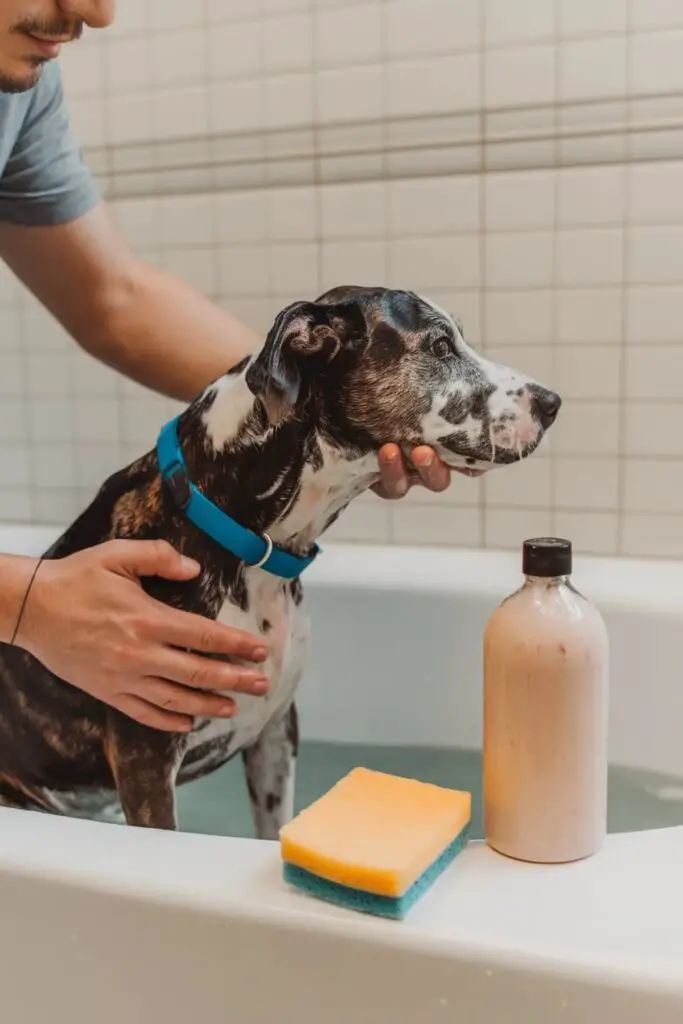
Bathing your dog with homemade shampoo can be a rewarding experience for both you and your furry friend. To ensure the process goes smoothly, it’s important to be well-prepared and follow a structured approach. Here are some essential tips to make bath time enjoyable and effective.
Preparing for Bath Time
Before you begin the bathing process, taking a few preparatory steps can make a significant difference:
- Brush Your Dog:
- Start by brushing your dog’s coat to remove loose fur and tangles. This not only minimizes the amount of hair that might clog your drain but also helps prevent mats from forming, which can be painful when wet.
- Use a suitable brush for your dog’s coat type. For example, slicker brushes work well for long-haired breeds, while bristle brushes are good for short-haired dogs.
- Choose a Comfortable and Safe Bathing Area:
- Select a bathing location that is safe and comfortable for your dog. Options include a bathtub, a shower stall, or even a large sink, depending on your dog’s size.
- Make sure the area is non-slip to prevent accidents. You can use a rubber mat or a towel on the bottom of the tub or sink to provide better traction.
- Ensure the water temperature is lukewarm, as water that is too hot or too cold can be uncomfortable for your dog.
Step-by-Step Bathing Guide
Once you’re prepared, follow these steps to ensure a thorough and gentle bath:
- Wet Your Dog’s Coat Thoroughly:
- Begin by using a handheld sprayer, cup, or pitcher to wet your dog’s coat thoroughly. Start from the neck and work your way down, being careful to avoid getting water in your dog’s ears and eyes.
- If your dog is nervous, you can make the process more comfortable by letting them sniff the water and getting them used to the sound before fully wetting them.
- Apply Homemade Shampoo and Lather Gently:
- Once your dog is wet, take your homemade dog shampoo and apply a generous amount directly to their coat. Use your hands or a washcloth to spread it evenly.
- Gently massage the shampoo into your dog’s coat, being careful to avoid the eyes, ears, and mouth. Focus on areas that tend to accumulate dirt, such as under the legs, around the tail, and on the belly.
- Create a rich lather, which will help lift dirt and debris while also providing a soothing massage for your dog. This is a great opportunity to bond with your pet!
- Rinse Thoroughly to Remove All Shampoo:
- After lathering, rinse your dog thoroughly with lukewarm water. It’s important to remove all traces of shampoo to prevent skin irritation.
- Check for any remaining suds, especially in areas with thick fur. Rinse until the water runs clear and no suds are visible.
Post-Bath Care
After the bath, proper care is essential to keep your dog comfortable and healthy:
- Dry Your Dog with a Towel or Blow-Dry on a Low Setting:
- Start by using a towel to gently dry your dog, removing as much water as possible. You can use an absorbent bath towel for this step, and make sure to be gentle, particularly around the face and ears.
- If your dog is comfortable with it, you can use a blow dryer on a low, cool setting to help dry their coat more quickly. Keep the dryer a safe distance away from their skin to avoid burns and keep the noise level low to prevent startling them.
- Brush Your Dog’s Coat to Prevent Matting:
- Once your dog is mostly dry, brush their coat again to prevent matting and ensure their fur stays tangle-free. This is especially important for long-haired breeds, as wet hair is more prone to tangling.
- Regular brushing not only keeps your dog looking good but also promotes healthy skin by distributing natural oils throughout their coat.
Bathing your dog with homemade shampoo can be a straightforward process if you follow these tips. With a little preparation and the right approach, you can ensure that your dog enjoys bath time while benefiting from the nourishing properties of your customized shampoo.
The Bottom Line
Choosing the best homemade dog shampoo can be a game-changer for your pet’s grooming routine, providing a natural and customized solution tailored to their specific needs. By understanding your dog’s skin and coat type, identifying any skin issues or allergies, and adjusting your recipes accordingly, you can create a shampoo that not only cleanses but also nourishes and soothes.
When bathing your dog, preparation is key. From brushing to selecting a safe bathing area, each step contributes to a more enjoyable experience for both you and your furry friend. Following a step-by-step guide during the bath ensures that your dog receives a thorough clean, while proper post-bath care helps maintain their coat’s health and shine.
Ultimately, using homemade dog shampoo not only supports your pet’s skin health but also promotes bonding time during grooming. By opting for natural ingredients, you can avoid the harsh chemicals found in many commercial products, leading to a happier, healthier pup. So grab your ingredients, embrace the art of DIY dog grooming, and enjoy the rewards of a clean, fresh-smelling companion!

Hi, I’m Ali Tarek, the founder of Animalsman. I’ve always been passionate about pets, especially dogs and cats, and I created this website to share practical tips, easy recipes, and helpful care advice for fellow pet lovers. My goal is to make pet care simple, enjoyable, and accessible for everyone. When I’m not writing or curating content, you’ll usually find me spending time with my furry friends or learning new ways to keep them happy and healthy.

